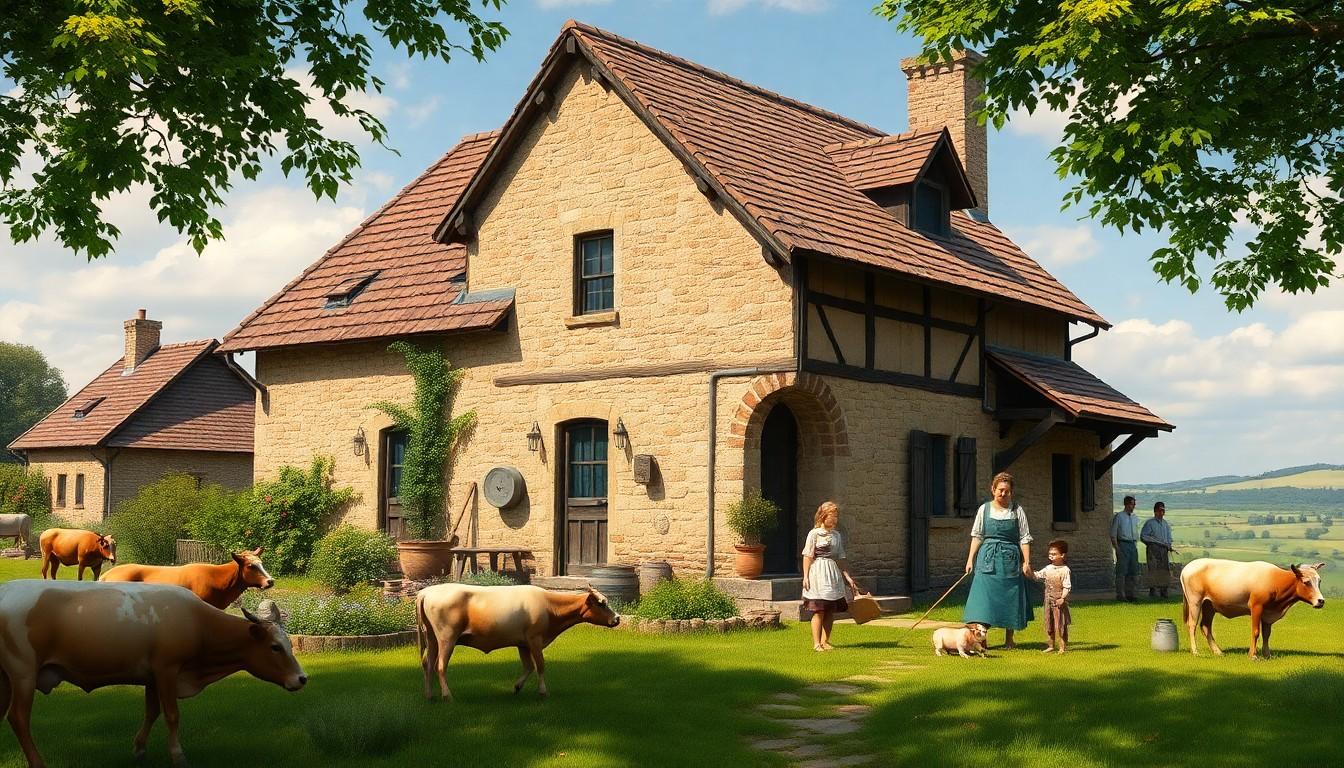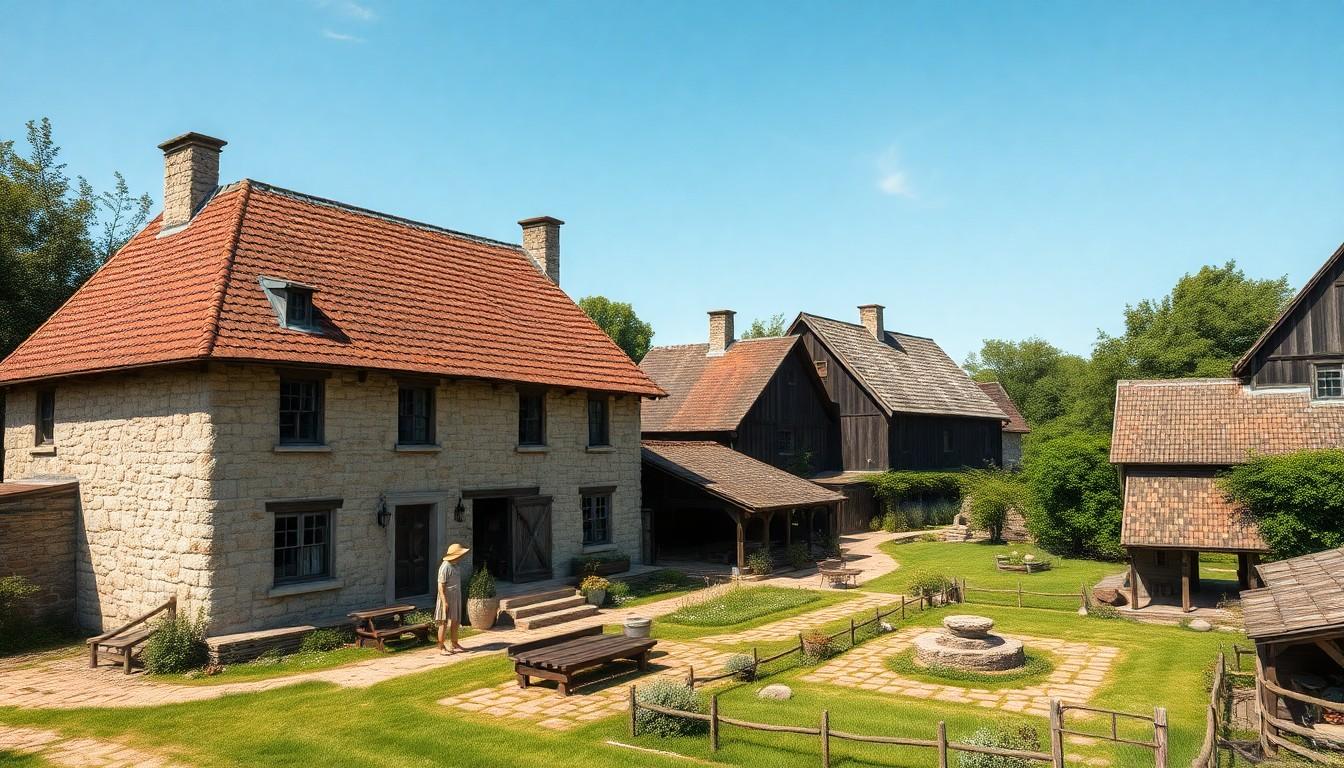Physical Address
304 North Cardinal St.
Dorchester Center, MA 02124

Picture this: rolling hills, quaint cottages, and the smell of fresh bread wafting through the air. Welcome to the world of 1800s Western European homesteads, where life was as charming as a Jane Austen novel but with a bit more mud and a lot less social media. These rustic abodes were more than just places to hang hats; they were the epicenters of family life, hard work, and perhaps the occasional sheep-shearing contest.
In an era where the phrase “home is where the heart is” truly meant something, homesteads reflected the spirit of resilience and community. They were the backbone of rural life, where folks turned dreams into reality with a bit of grit and a whole lot of elbow grease. Dive into the fascinating world of these homesteads and discover how they shaped the lives of those who called them home.
Homesteads in 1800s Western Europe reflected a unique blend of practicality and simplicity. These properties typically consisted of a main dwelling, barns, and other outbuildings, all arranged around a central courtyard. Families lived in these structures, fostering close familial and community ties in rural settings.
Architectural styles varied considerably across regions, with each reflecting local traditions and available materials. For example, stone houses were prevalent in parts of England and France, while timber-framed homes characterized much of Germany and Scandinavia. Roofs often featured thatch or tiles, chosen based on climate and resources.
Gardens were essential components of these homesteads, providing vegetables, herbs, and sometimes fruits. Crop rotation practices maximized soil fertility and supported subsistence farming. Livestock, including cows, pigs, and chickens, also played a crucial role, offering meat, milk, and eggs.
Social structures within these homesteads emphasized community roles. Often, neighbors collaborated on agricultural tasks, sharing labor during busy seasons like harvest. Events such as barn raisings or community feasts strengthened bonds among families, illustrating the homestead’s significance beyond mere shelter.
The economic landscape shaped reliance on homesteads, as many families depended on agriculture for their livelihoods. Agricultural advancements, including the introduction of new tools and techniques, improved productivity. However, challenges such as harsh weather, illness, and conflicts also arose, testing the resilience of homestead life.
These homesteads stood as symbols of endurance, preserving the culture and lifestyle of Western Europe in the 1800s. They provided not just physical shelter but a sense of belonging and purpose, crucial during this transformative period in history.

Architectural styles of 1800s Western European homesteads blend functionality with aesthetic appeal. These structures exhibit features that cater to rural living while reflecting regional craftsmanship.
Buildings commonly feature thick walls, which provide insulation against harsh weather. Roofs often slope steeply, allowing snow to slide off easily. Windows typically maintain a small size, prioritizing durability and energy efficiency. Local materials shaped construction, emphasizing stone and timber dependence. Courtyards served as communal spaces for work and family gatherings, fostering connections among residents. Barns and outbuildings provided necessary storage for tools and livestock, supporting agricultural life.
Regional variations significantly influenced homestead designs. England’s stone houses exhibit sturdy constructions that withstand time. French homesteads often integrate intricate facades and prominent chimneys, showcasing local artistry. Timber-framed homes in Germany feature exposed beams, emphasizing craftsmanship. Scandinavian styles highlight practicality alongside charm, with tightly clustered structures optimizing space. These regional styles reflect environmental conditions and cultural traditions, showcasing the diversity of homestead architecture across Western Europe.
Life on 1800s Western European homesteads revolved around family, agriculture, and community collaboration. Each day unfolded with a focus on sustaining the household and nurturing social bonds.
Roles within the family unit varied and were crucial for efficient homestead operation. Women often managed the household, tending to children and preparing meals. Men typically handled outdoor tasks, including farming and livestock care. Children contributed significantly, performing age-appropriate chores such as gathering eggs and helping in the garden. Cooperation was essential; family members relied on each other’s strengths to maintain daily routines and agricultural tasks. This division of labor ensured the homestead remained productive and resilient.
Agricultural practices formed the backbone of homesteads in the 1800s. Crop rotation was common, enhancing soil fertility and maximizing yields. Families grew vegetables like potatoes, carrots, and cabbage in their gardens. Livestock, including cows, pigs, and chickens, played a vital role, providing meat, milk, and eggs for sustenance. Seasonal cycles dictated planting and harvesting times, with families working together to complete these tasks efficiently. Community gatherings often coincided with peak harvest times, reinforcing social networks while sharing the fruits of their labor.
Homesteads in the 1800s significantly influenced social dynamics and economic practices in Western Europe. Community collaboration played a vital role, with neighbors often assisting each other during busy agricultural seasons, fostering strong bonds among families. Celebrations and shared events further strengthened these connections, creating a supportive social network that was essential for survival.
Economic structures relied heavily on agriculture, where families cultivated crops and raised livestock. Income generated from selling excess produce at local markets contributed to household sustainability. Crop rotation methods improved soil quality and boosted yields, enhancing overall productivity. Survival during harsh weather conditions or illness posed challenges, yet resilience marked many homesteads.
Local craftsmanship influenced economic practices, as families utilized available materials for construction and farming tools. This reliance on regional resources not only facilitated cost-effective homestead maintenance but also resulted in unique architectural styles reflective of local culture. Homesteads served as a microcosm of the greater economy, blending subsistence farming with market participation, showcasing the adaptability of rural communities.
Each homestead also served as a hub of educational development. Knowledge sharing among family members and neighbors ensured skills passed down through generations. Children gained practical experience through chores, fostering a strong work ethic as they learned essential agricultural practices. This hands-on approach cultivated a sense of responsibility and connection to the land.
Social structures within these homesteads mirrored broader trends in Western Europe during this transformative period. Hierarchical relationships emphasized family roles, with clear divisions of labor yet an overall spirit of cooperation. These dynamics shaped the unique character of homesteads, exemplifying the profound impact of agriculture and community interaction on social and economic outcomes in rural life.
Preservation of 1800s Western European homesteads plays a crucial role in maintaining cultural heritage. Many organizations focus on safeguarding these historical sites, recognizing their significance in understanding rural life and architectural evolution. Local governments often support restoration projects by providing funding and expertise for authentic refurbishments.
Heritage centers frequently offer educational programs, allowing visitors to engage with history through immersive experiences. Visitors learn about traditional farming techniques and crafts, fostering appreciation for the lifestyle that shaped many communities. Seasonal events, such as harvest festivals, enable local families to celebrate their agricultural roots, while highlighting the role of homesteads in sustaining community identity.
Cultural heritage relies on documentation and research, promoting a better understanding of homestead life. Publications emphasizing oral histories and photographs provide insight into daily routines, agricultural practices, and social structures. Preservationists emphasize the importance of maintaining architectural integrity, ensuring that restoration efforts reflect the original craftsmanship.
Efforts to document these sites often bring attention to overlooked histories and marginalized communities. Collaboration between historians, architects, and local residents fosters a comprehensive narrative of the era. By focusing on the unique aspects of individual homesteads, preservation initiatives enhance awareness of regional variations in design and function.
Community engagement remains vital in preservation efforts. Residents often participate in efforts to conserve local homesteads, illustrating a shared commitment to heritage. Volunteers join together for restoration projects, helping to maintain the physical structures while connecting with their history. Through these endeavors, the legacy of 1800s Western European homesteads endures, offering invaluable lessons about resilience, community, and cultural continuity.
Preserving these homesteads captures the essence of an era characterized by hard work and collaboration. Archaeological sites, architectural features, and social structures continue to inform present and future generations about their rich agricultural history.
The legacy of 1800s Western European homesteads continues to resonate today. These structures not only represent architectural ingenuity but also embody the spirit of community and resilience that defined rural life during that era. By preserving these homesteads, future generations can gain insight into the agricultural practices and social dynamics that shaped their ancestors’ lives.
Engaging with this rich heritage fosters a deeper appreciation for the interconnectedness of family and community. As efforts to maintain these sites grow, they ensure that the stories and traditions of the past remain alive. Ultimately, the enduring significance of these homesteads lies in their ability to teach valuable lessons about sustainability, cooperation, and the importance of cultural identity.